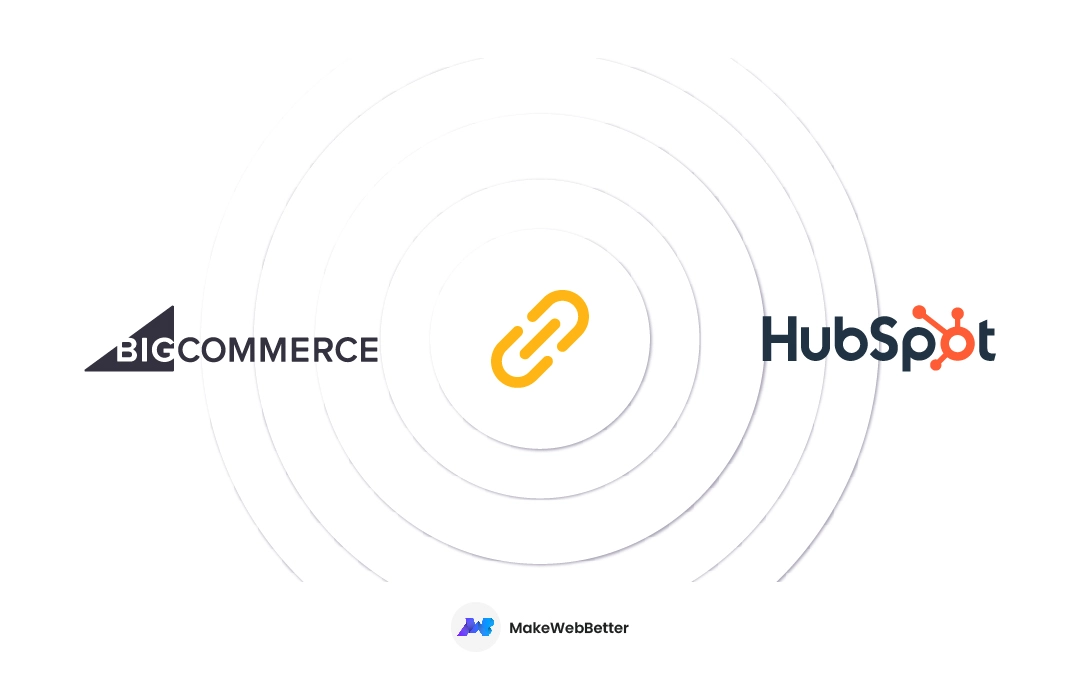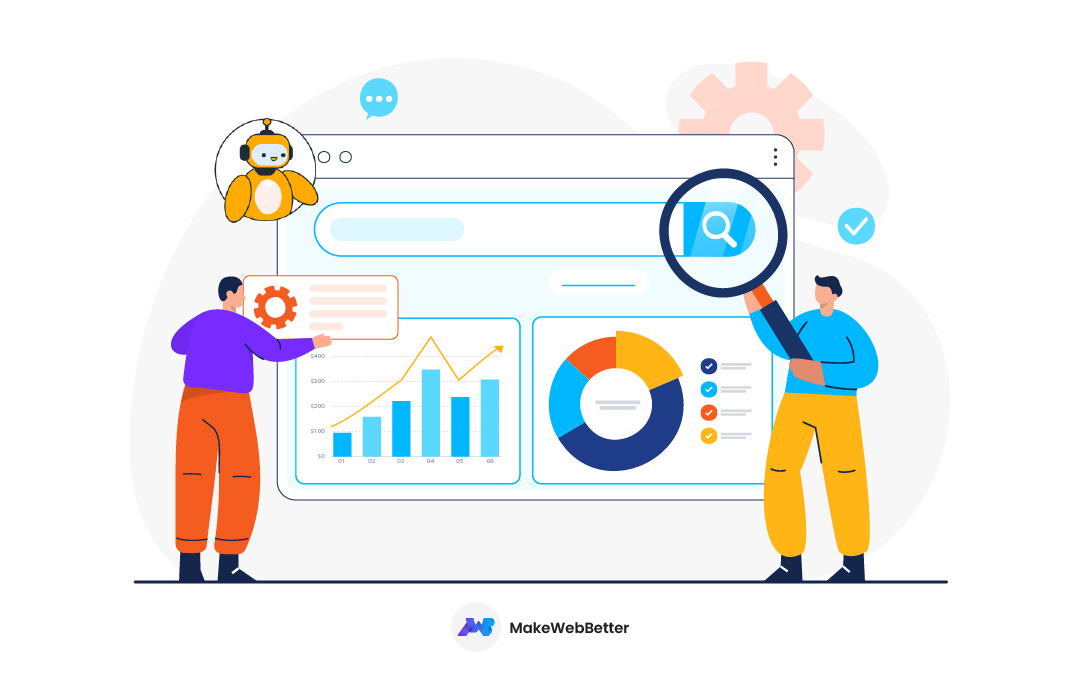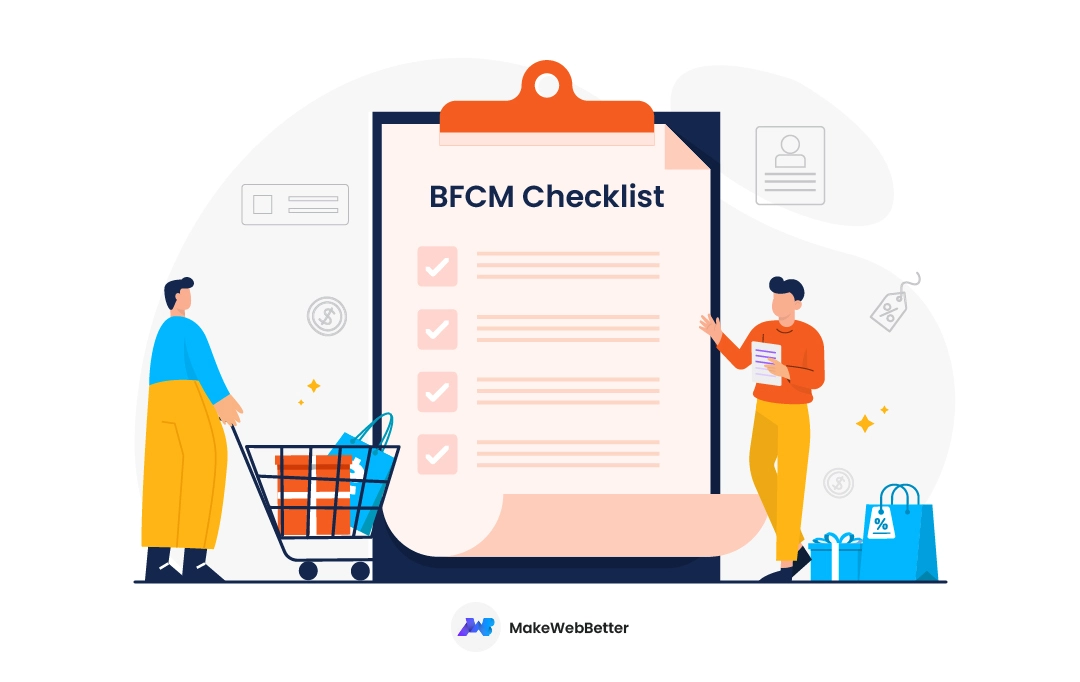Running an online business on BigCommerce? I bet it sucks.
You need to track sales, market products, talk to clients, manage refunds.
The list goes on.
You cannot do all of it with a smile on your face.
But there are tools that will bring a sigh of relief on your face if you connect your BigCommerce store with them.
One of them is HubSpot. And this post will tell how you can connect BigCommerce to HubSpot and enjoy running your online business.
Let’s get to it.
Why Connect BigCommerce to HubSpot? Statistical Reasons.
You’ll experience several benefits if you connect BigCommerce to HubSpot. But I’ve talked about them later in this post.
I’d like to answer this question with some stats and data.
Here we go.
- With 58% usage distribution, HubSpot is the most popular tool in the CRM category on the entire internet.
- In 2022, HubSpot Sales Hub was one of the most loved on TrustRadius.
- Again on TrustRadius, HubSpot Sales Hub was among the top rated tools for 4 consecutive years since 2019.
- Currently, there are 533,682 live websites using HubSpot.
- Industry giants like Accenture, Doordash, Reddit, Tumblr, use HubSpot.
- HubSpot has over 167K customers worldwide.
- In 2022, HubSpot generated $1.7 billion of revenue.
The data above show that people love HubSpot. The biggest giants in the industry trust and use HubSpot because it makes the daily job so much easier. So if you want to get the best results at your business, you can also give it a shot.
It’s totally free to try.

Max out your HubSpot CRM performance for FREE!
Grab our free HubSpot audit guide. Optimize your CRM using it and get better results with the platform.
How to Connect BigCommerce to HubSpot?
You will need a 3rd party tool to connect your BigCommerce store to HubSpot.
And being a HubSpot elite solutions partner, we’ve developed an app that does the same.
It’s called HubSpot BigCommerce integration.
Using this app, you can connect your store to the CRM within 5 minutes. Faster than brewing your black coffee.
Let’s look at the steps to do that.
1/ Install HubSpot BigCommerce Integration
Estimated time: 1 minute
Go to BigCommerce Marketplace and search for HubSpot. Click on HubSpot Integration by MakeWebBetter.
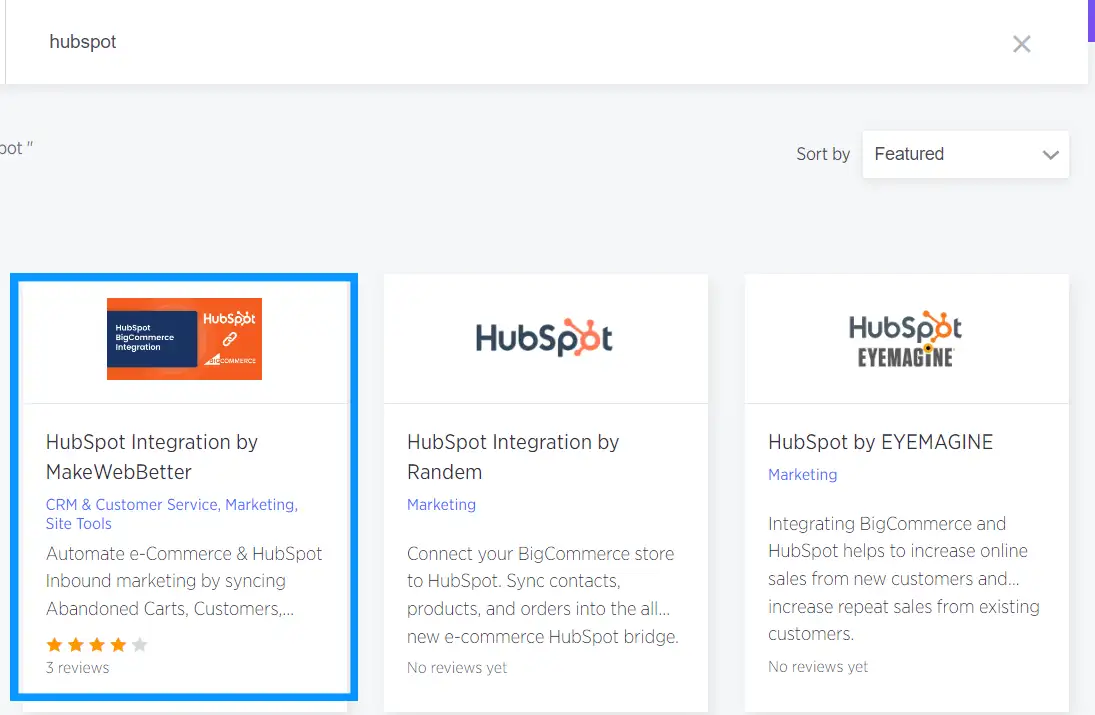
You’ll land on the app’s page and see a button saying GET THIS APP. Click on it to sign up or log into your BigCommerce account.
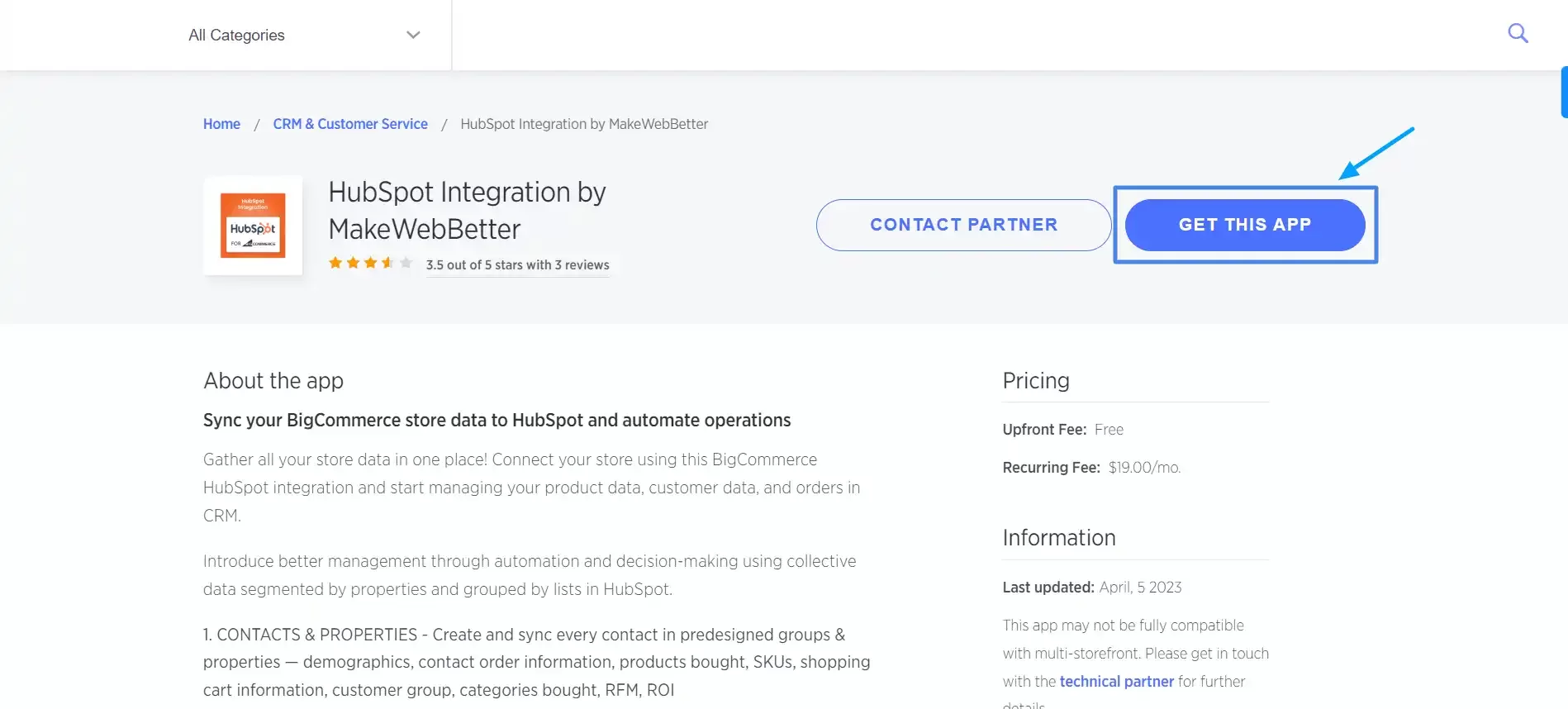
Now log in to your BigCommerce store (or Sign Up if you don’t have one).
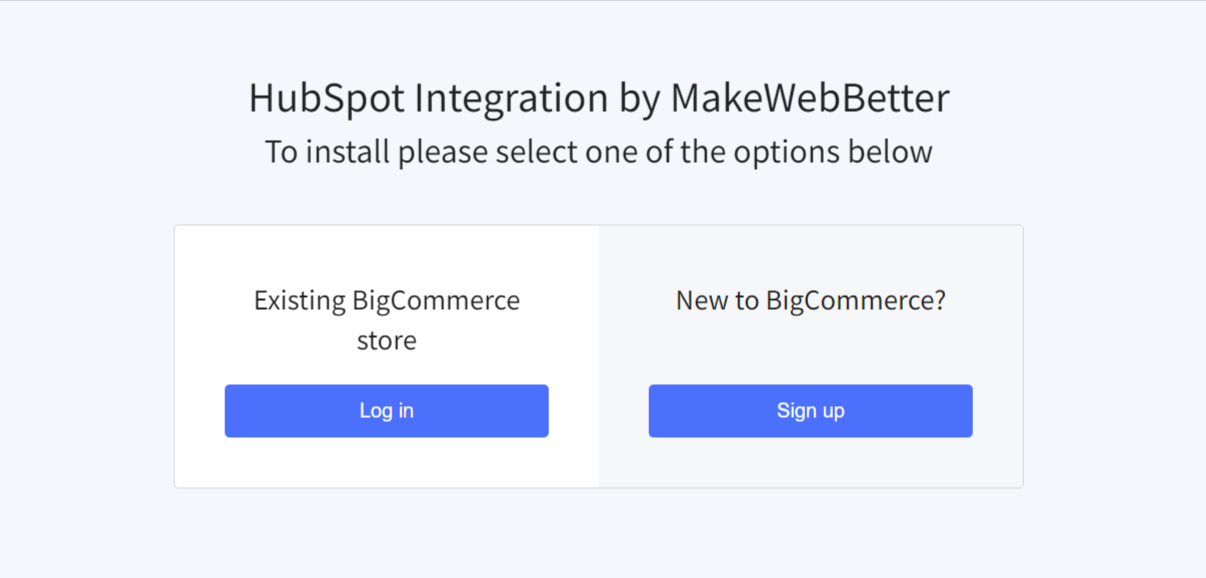
I presume that you already have a store and logged into it. After doing that, you’ll land on the Installation window of the app. Click on the Install button you see there and the app will be installed in your BigCommerce dashboard.
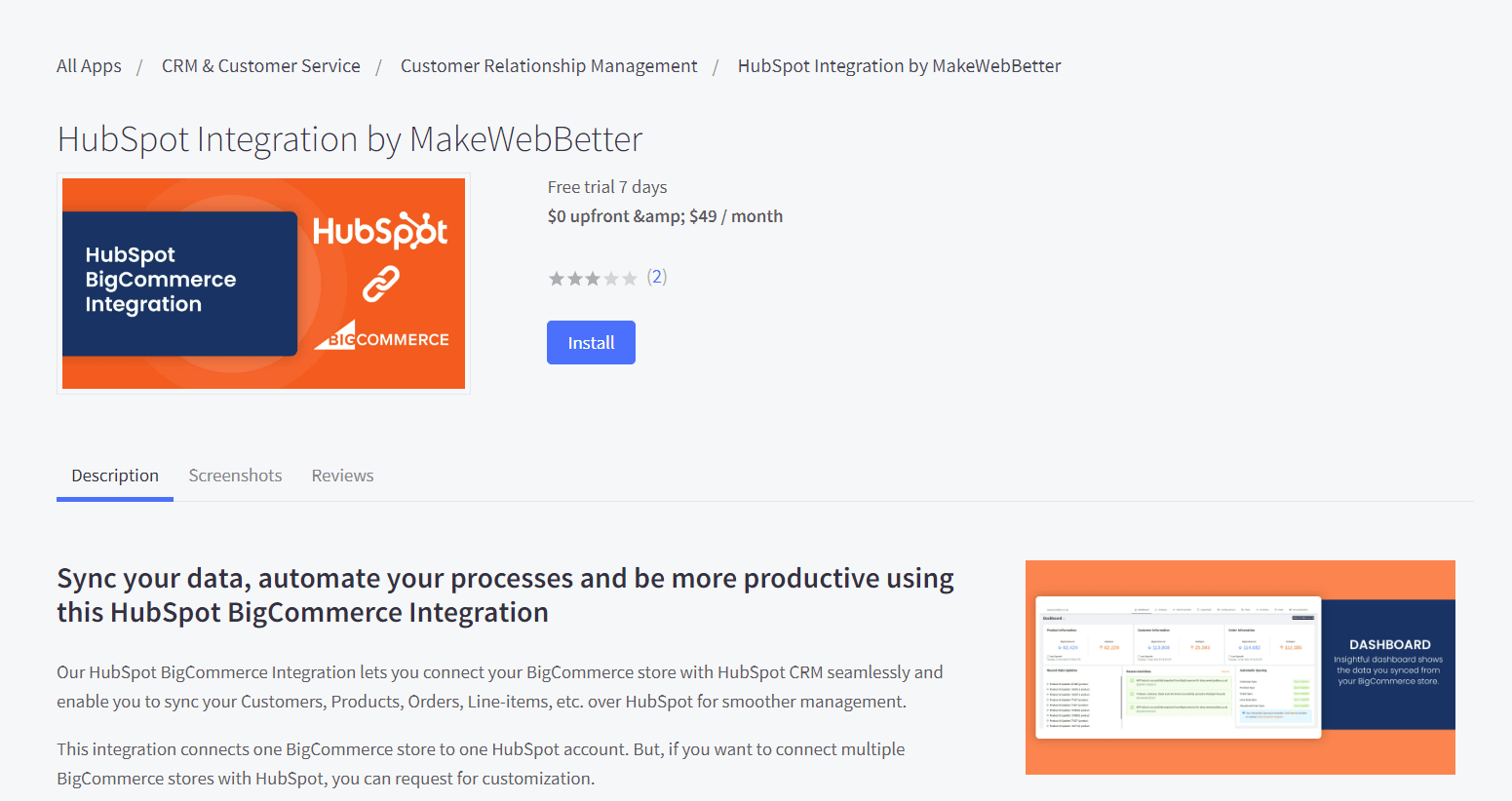
The installation will finish in a few seconds and you’ll see the compliance notice. Click on the Confirm button to move forward.
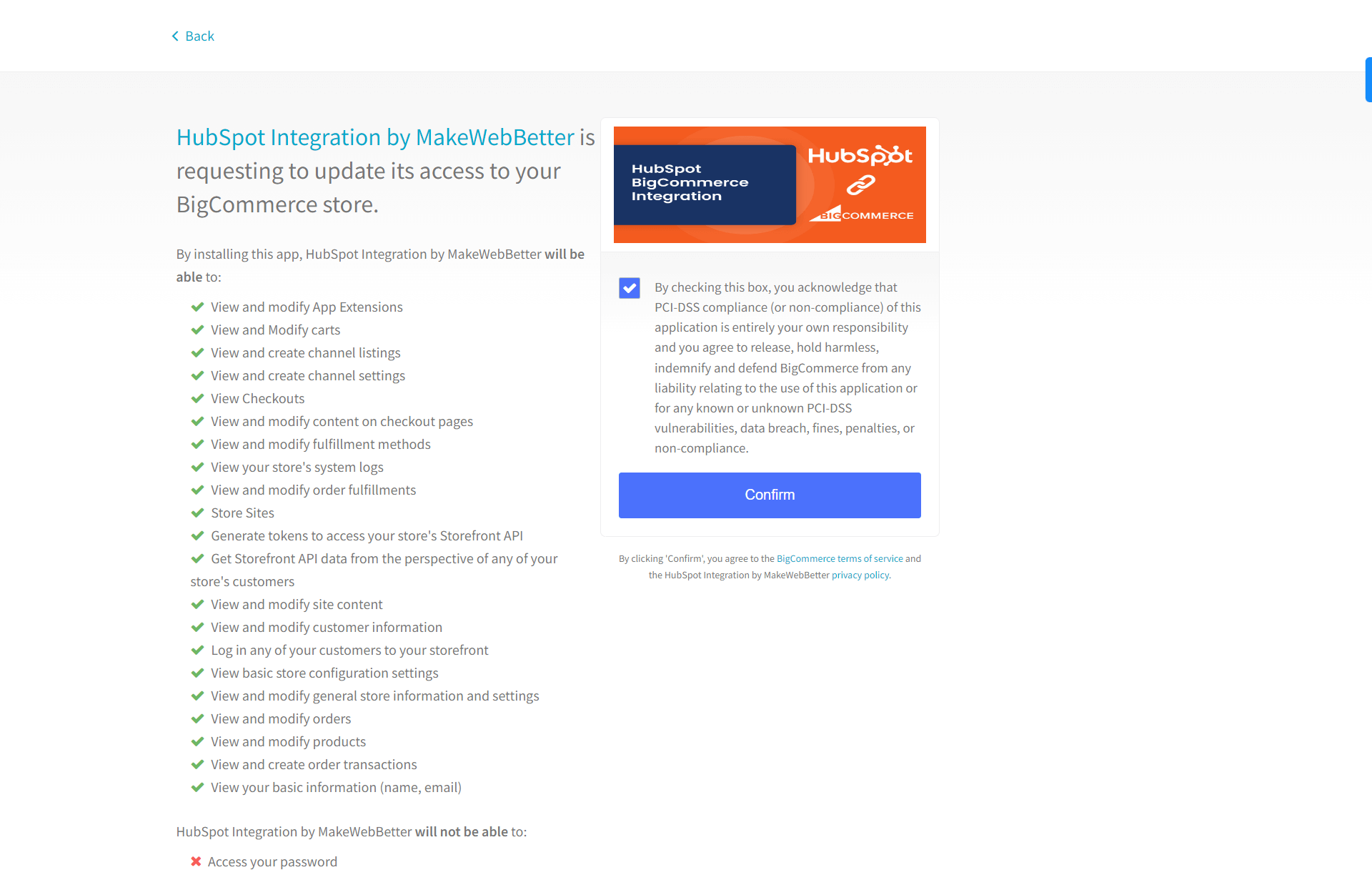
2/ Setup HubSpot Integration by MakeWebBetter
Estimated time: 2 minutes
Now you’re ready with your HubSpot integration. You just need to set it up to get things started.
Open the HubSpot BigCommerce app and you’ll land on a screen like this.
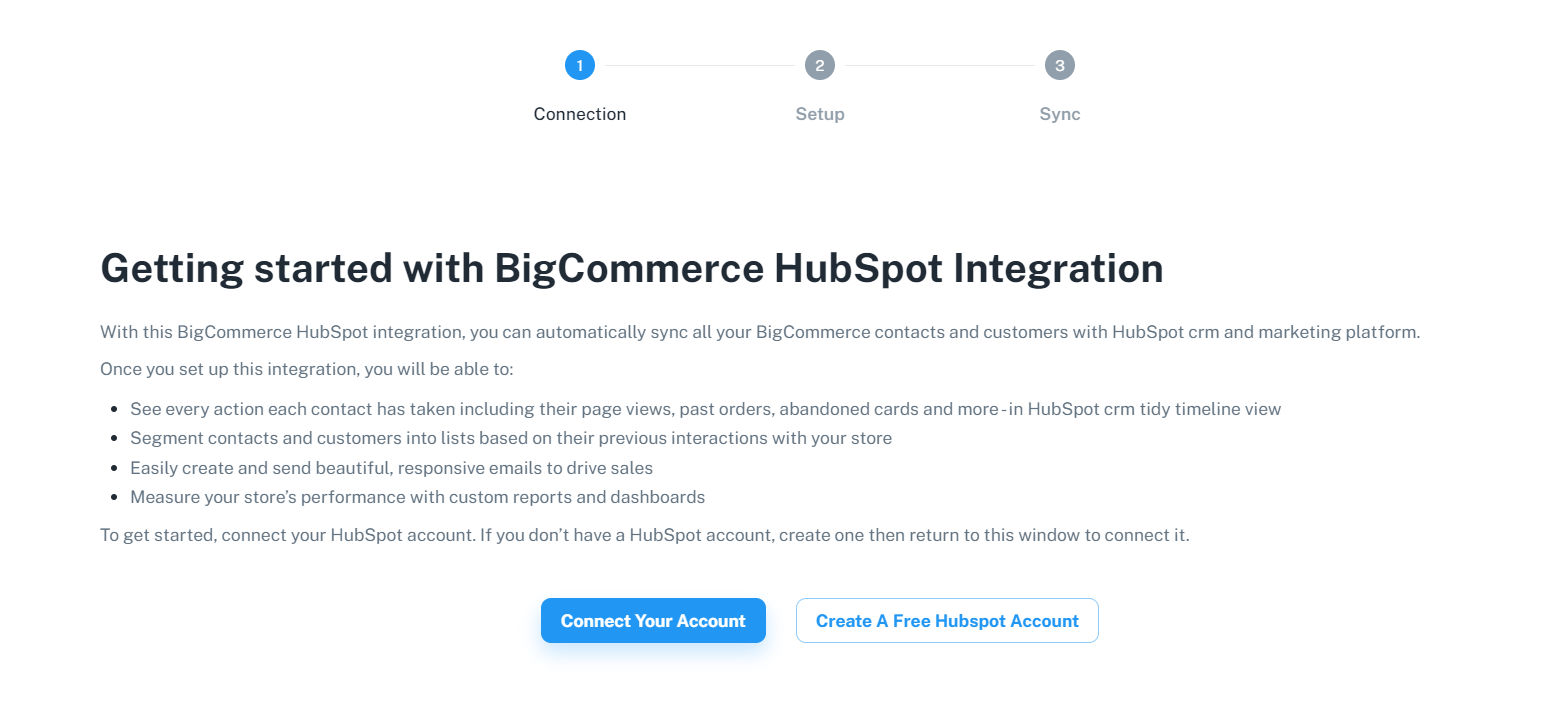
Click on Connect your account to choose the HubSpot portal you want to sync data to. Create a HubSpot account if you don’t have one.
After clicking Connect your account button, you’ll see a window with all the HubSpot accounts connected to your email.
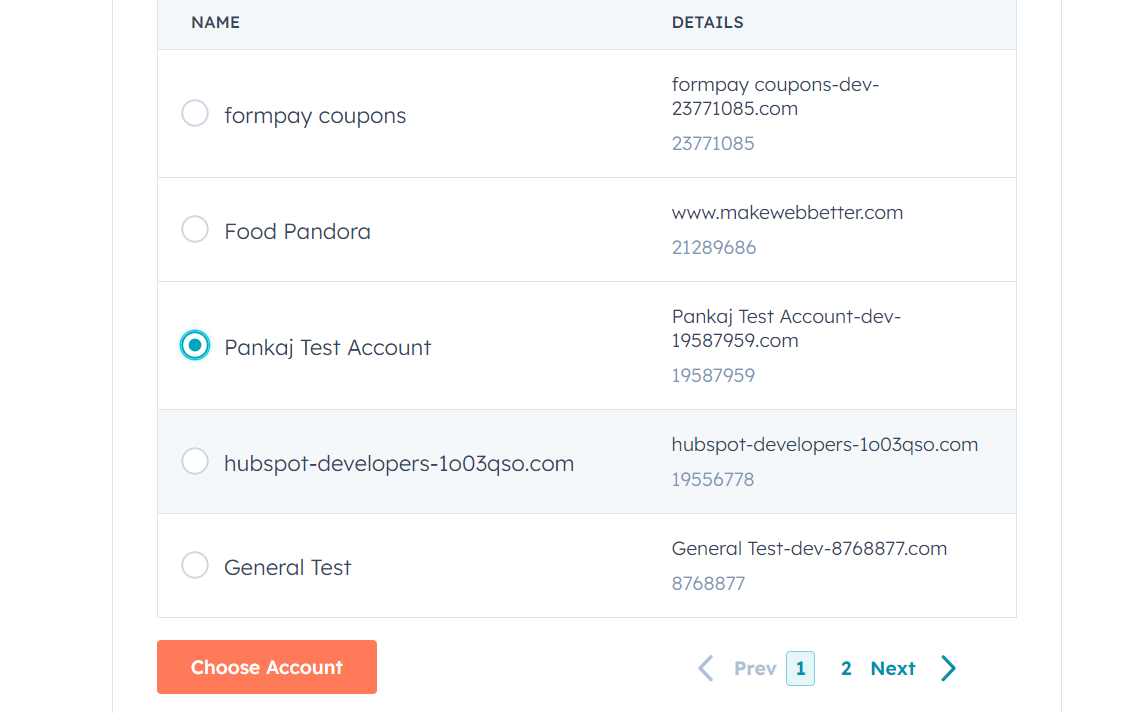
Select the account you want to connect and click Choose account. Click on Connect app to link your HubSpot account to BigCommerce.
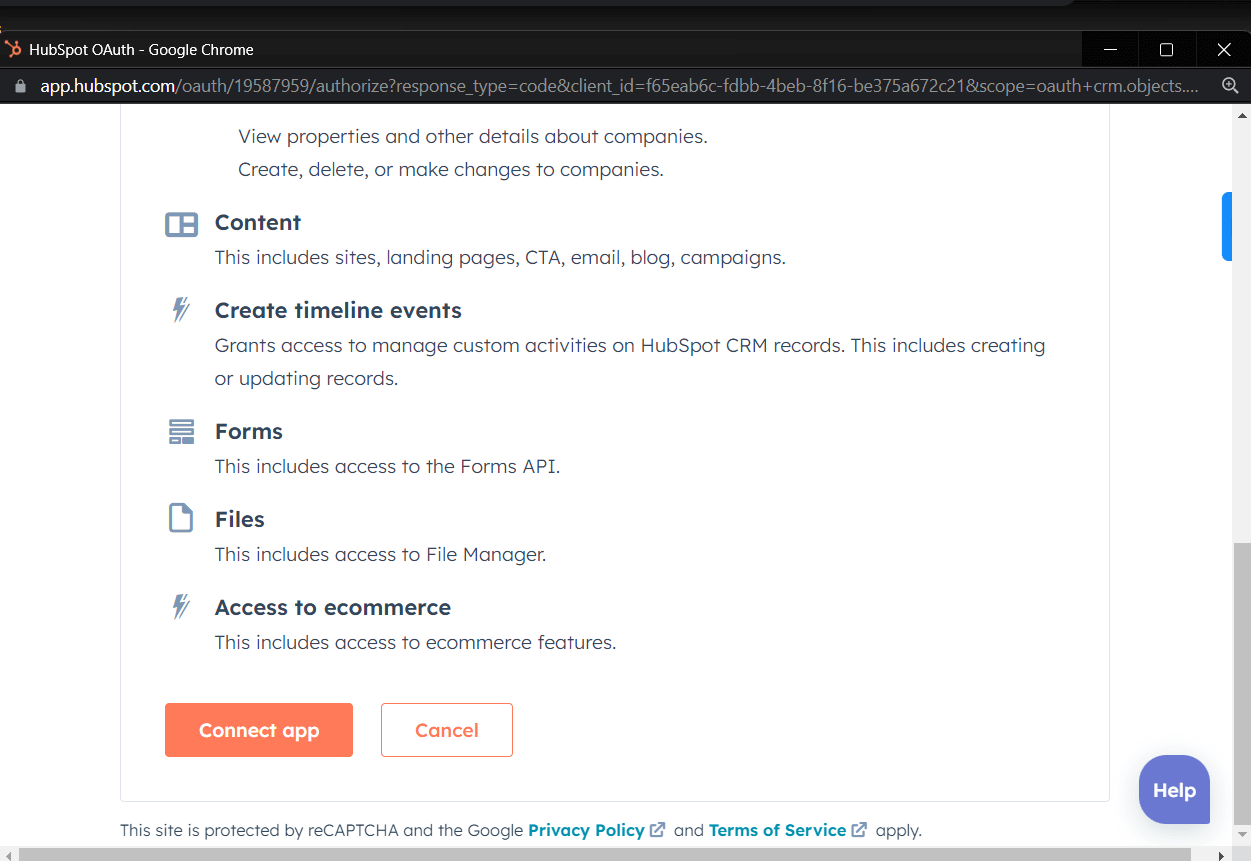
Once your account is connected, the plugin will ask you if you want to perform these quick steps:
-
Setup Groups and Properties

This will create properties in your HubSpot CRM and help you store your BigCommerce data.
Click Create groups & properties button and the rest will be done automatically.
-
Create Lists for Segmentation

Creating lists will help you segment your contacts based on different criteria so you can create personalized content they resonate with. Click on Create lists button to build them into HubSpot.
-
Create Workflows for Automation

Workflows will automate your redundant tasks that do not require deep supervision. For example, sending a welcome email to a new user. Click Create workflows and the app will create workflows in your HubSpot portal.
-
Map Pipeline Stages for Both Platforms
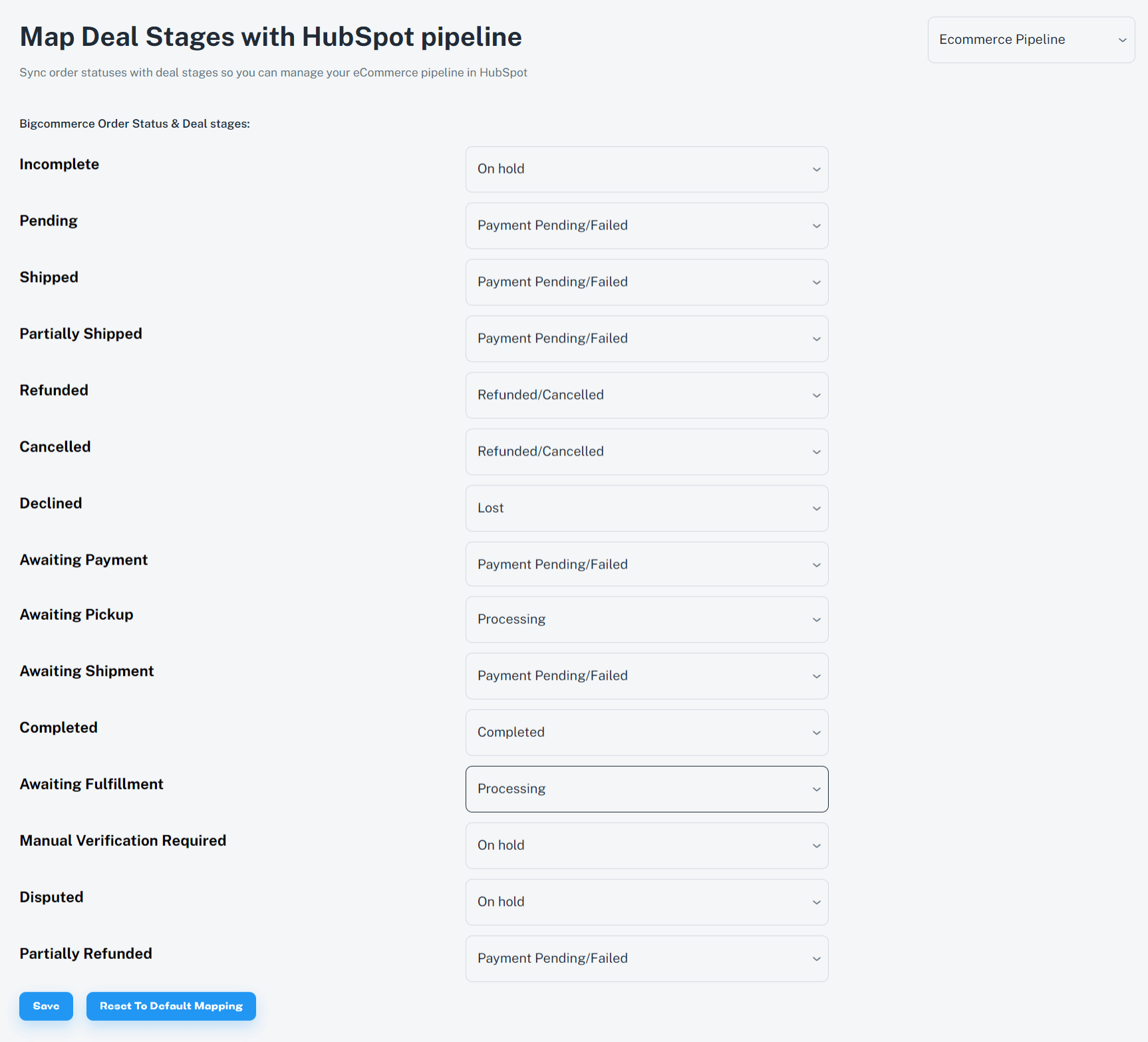
Map order status of your BigCommerce store with HubSpot deal stages to ensure your orders move to the right HubSpot stage if the status is changed in your online store. Select your pipeline and stages, map them and click Save. You can also go with the default mapping.
-
Sync Existing Data to HubSpot
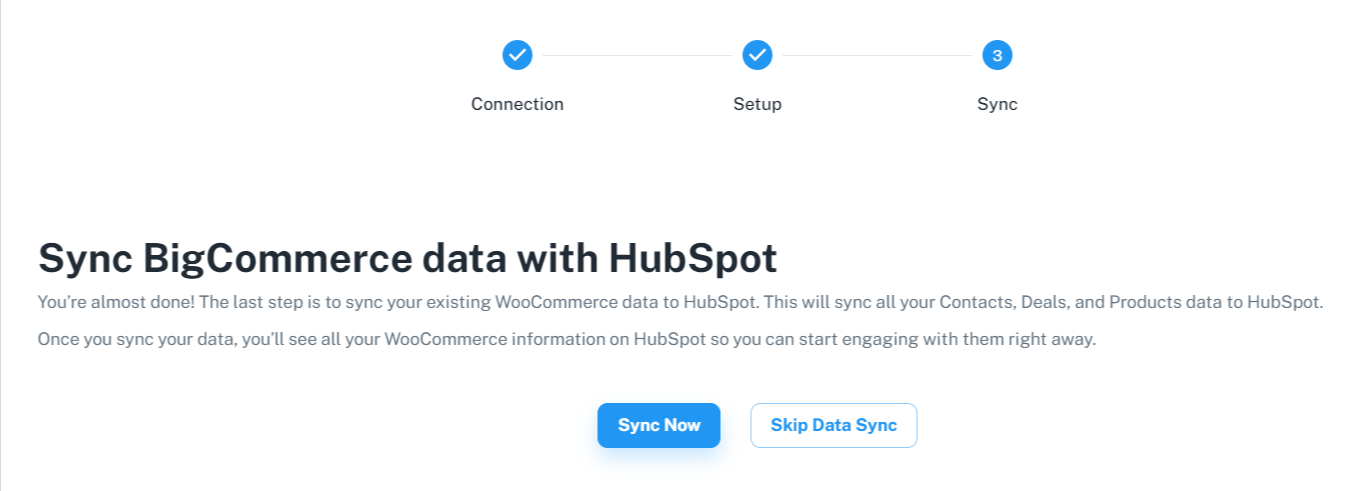
If you already have some data on your BigCommerce store, click Sync now to send it to the HubSpot. However, if you don’t have any data or have a lot of it, I’d suggest you to click the Skip data sync option.
That’s all. You’ve connected BigCommerce with HubSpot successfully.
It may look like there are a handful of steps. But it doesn’t take time to finish them. You can configure your HubSpot BigCommerce app under 2 minutes and sync your store data to the CRM.
Streamline Your BigCommerce Store Tasks with HubSpot!
Integrate BigCommerce with HubSpot with our HubSpot BigCommerce connector and ease up your marketing and sales tasks.
That’s how you can connect BigCommerce to HubSpot CRM. It may look like there are a handful of steps. But they only take less than 5 minutes to complete IRL.
Now you’ve connected both platforms, congratulations.
But there’s more.
You need to ensure you get maximum results to justify your investment in the app. To do that, you must configure the app the right way.
Let’s see how you can do that.
How to Configure HubSpot BigCommerce App for Maximum Results
1/ Import/Export Data
Using this HubSpot BigCommerce integration, you can import your BigCommerce data and then export it to your HubSpot CRM.
To do this, navigate to HubSpot > Import/Export and you’ll see both options for importing and exporting data.

Select your data type, date range and click Import data to send your BigCommerce data to our database. Once you import the data, you can follow the same process to export it. Click on Export data to send it to your HubSpot CRM from our database.
2/ Configure HubSpot BigCommerce Integration
There are some more settings this BigCommerce HubSpot integration comes with. You can configure them to unlock more benefits.
Let’s look at some of these settings:
a. Abandoned Cart Settings

Click on Configuration in the app and expand the Automate Sync option. You’ll see the Abandoned Cart setting there. Enable that checkbox.
This setting will sync all your abandoned cart data to HubSpot CRM. You can then run email workflows to recover those abandoned carts and revenue.
b. RFM Settings

In the Configuration tab, you’ll find the RFM settings as well. With RFM segmentation, you can rate your customers from 1 to 5 based on their buying behavior.
Understanding the buying behavior of your customers helps you design tailored marketing campaigns that bring the best outcomes to your business.
Dan Gray from Vendry says,
He added, I’ve previously ran email marketing campaigns related to products that a customer purchased before. When that product was now available in a different color or back in stock, we’d send them an automated email showcasing that new item, resulting in incremental sales exceeding 6-figures.
So with these RFM ratings in the app, you can segment those customers into different groups like High Spenders, Loyal Customers, Repeat Buyers, etc. After you segment those users, you can target them through campaigns they’re more likely to engage with.
For example, if you pitch high-priced products to low spenders, they’d not consider it. So you need to target them with the products they’re more likely to buy and don’t cost a fortune.
All of these things can be done easily when you segment them on their buying pattern.
c. ROI Calculation Setting

There’s another setting in the Configuration section. It lets you select a deal stage you treat as won. In your HubSpot CRM, all the revenue in this stage will accumulate and displayed so you can calculate your ROI.
3/ View Sync Log Details
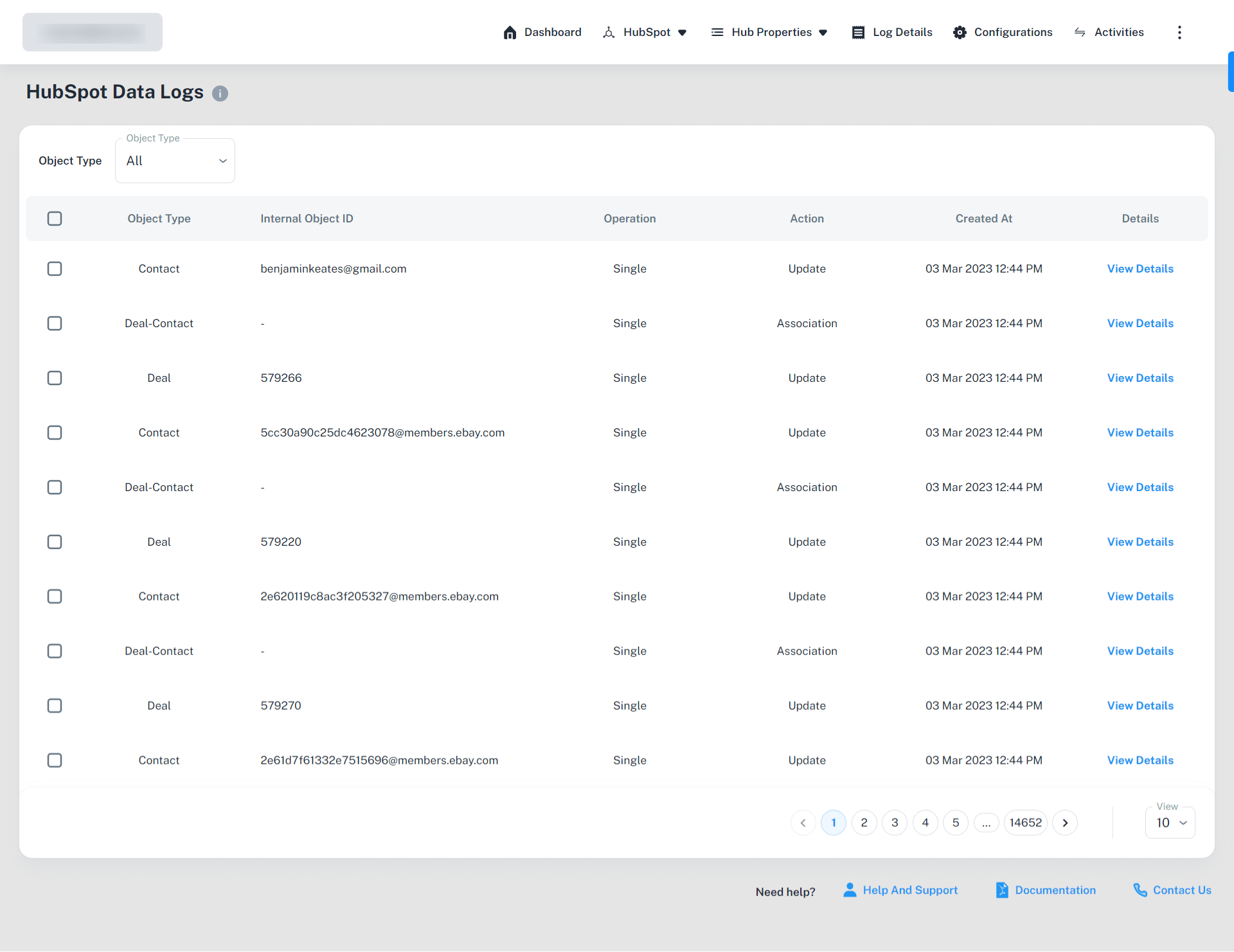
Whatever data synced(or didn’t sync) successfully will be logged here,
So you can track each activity you performed through this app. This section shows everything whether a record sync successfully or an error occurred. You can view details like Object Type, Internal Object ID, Operation, Action and more.
Benefits of Connecting BigCommerce to HubSpot
But why should you connect BigCommerce to HubSpot in the first place?
The answer lies in the benefits of it.
Let me uncover some benefits of connecting both platforms.
-
Smooth Recovery of Lost Revenue
Abandoned carts have always been painful for online businesses.
Every year, eCommerce businesses lose $18 Billion of sales revenue because of abandoned carts.
Recovering those carts can bring more revenue to your business.
However, recovering the abandoned carts isn’t always easy. But if you use our HubSpot BigCommerce integration to link both the platforms, you won’t face any trouble doing so.
The BigCommerce HubSpot integration syncs your abandoned carts’ data over HubSpot CRM.
You can use this data to frame a perfect abandoned cart recovery email. This email will contain a link to their cart. Users can click this link to go to their cart and complete the purchase.
-
Happy Customers with Better Experience
80% of the people are more likely to purchase from brands that offer a personalized experience.
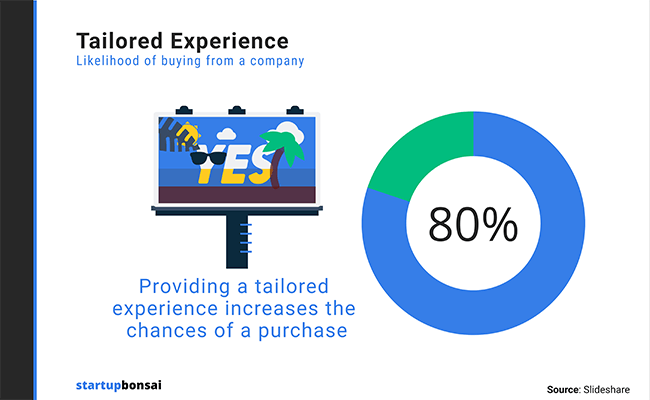
When you connect BigCommerce to HubSpot CRM, you can track your user activities and deliver personalized emails to provide a tailored experience to them.
Offering personalized experience to your customers strengthens your relationships with them.
According to Ryan Mckenzie, CMO of Tru Earth,
Simply put, connecting BigCommerce with HubSpot will help you deliver the content that addresses their pain points. Leading to more happy customers.
-
Close More Deals Like A Pro
Integrating BigCommerce to HubSpot helps you create personalized upselling and cross-selling offers. As a result, more impulse purchases and closed deals.
Like whenever a user purchases a product, you can send an email recommending some other relevant products to it.
Users can open these emails, navigate to these products and end up purchasing them, which multiplies your sales.
-
Automate Boring Tasks
As an eCommerce business, there are a handful of tasks that aren’t enjoyable enough.
You send welcome emails to every new user, or outreaching customers with the same follow up email.
Performing these tasks don’t just eat your time but also kill your productivity.
What’s worse is you have to perform these tasks every day.
But when you connect BigCommerce to HubSpot, you can automate such tasks using HubSpot workflows to save your time while doing more.
-
Break Team Silos and Improve Collaboration
CRM makes collaboration silky-smooth.
52% of companies look at CRM technology to reduce the silos between teams.
With HubSpot CRM, your reps can update their end of information for a record to improve collaboration.
For example, a marketer can communicate with a lead and once she’s ready to purchase, the marketer can create a task for the sales rep with all the relevant information about the lead. This way, the sales team will end up with all the information needed to convert the lead into a customer.
-
Accurate Sales Planning and Prediction
HubSpot CRM lets you track your sales with deals.
But that’s not it. Using HubSpot deals you can forecast and plan your sales.
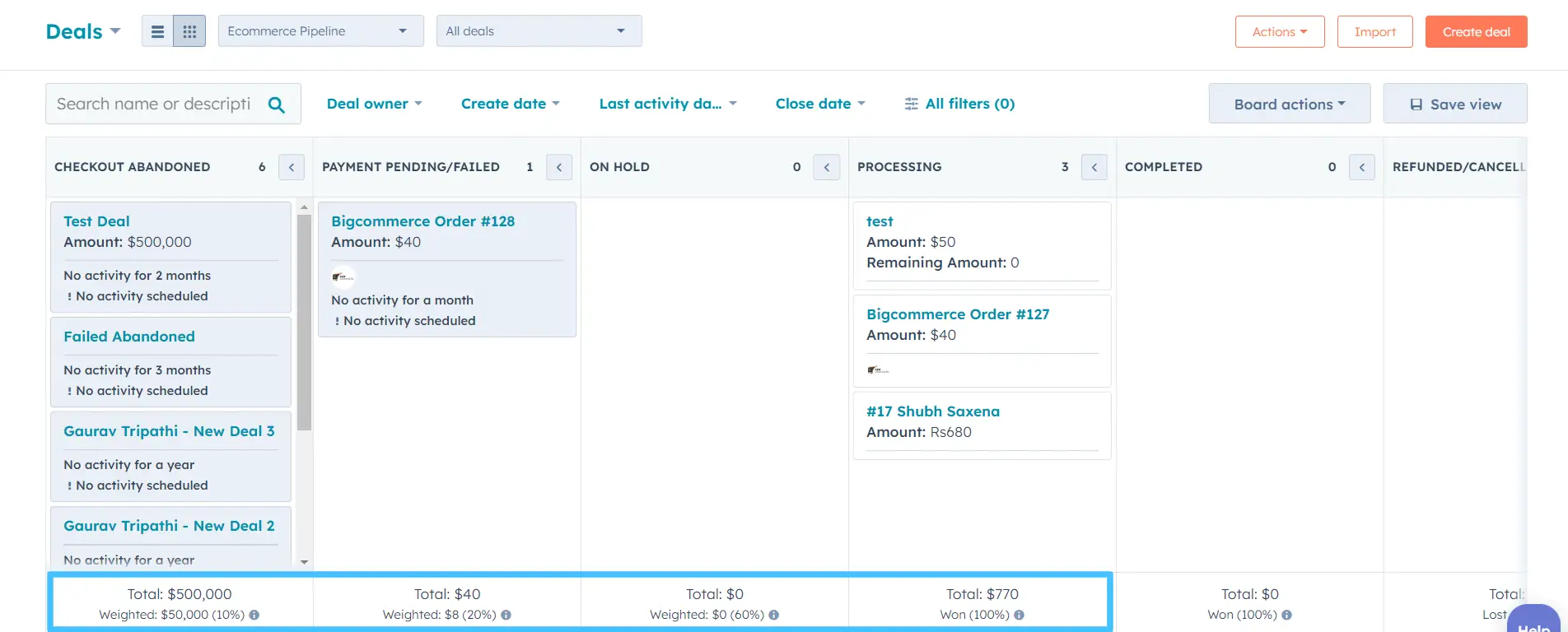
You can check the exact revenue stuck in every deal stage in your HubSpot CRM. This makes it easy to predict your sales and plan it as well accordingly.
-
Better decision making with in-depth reports
A CRM software can increase your report accuracy by 42%. Maybe that’s the reason behind 82% of brands using a CRM for sales reporting and process automation.
Using HubSpot reports, you can stop making decisions out of thin air and start hitting the bullseye.
The CRM offers in-depth reporting so you can keep a close eye on every nitty gritty of your business. This fills you with meaningful insights and tells you about your struggling areas and the strong zones.
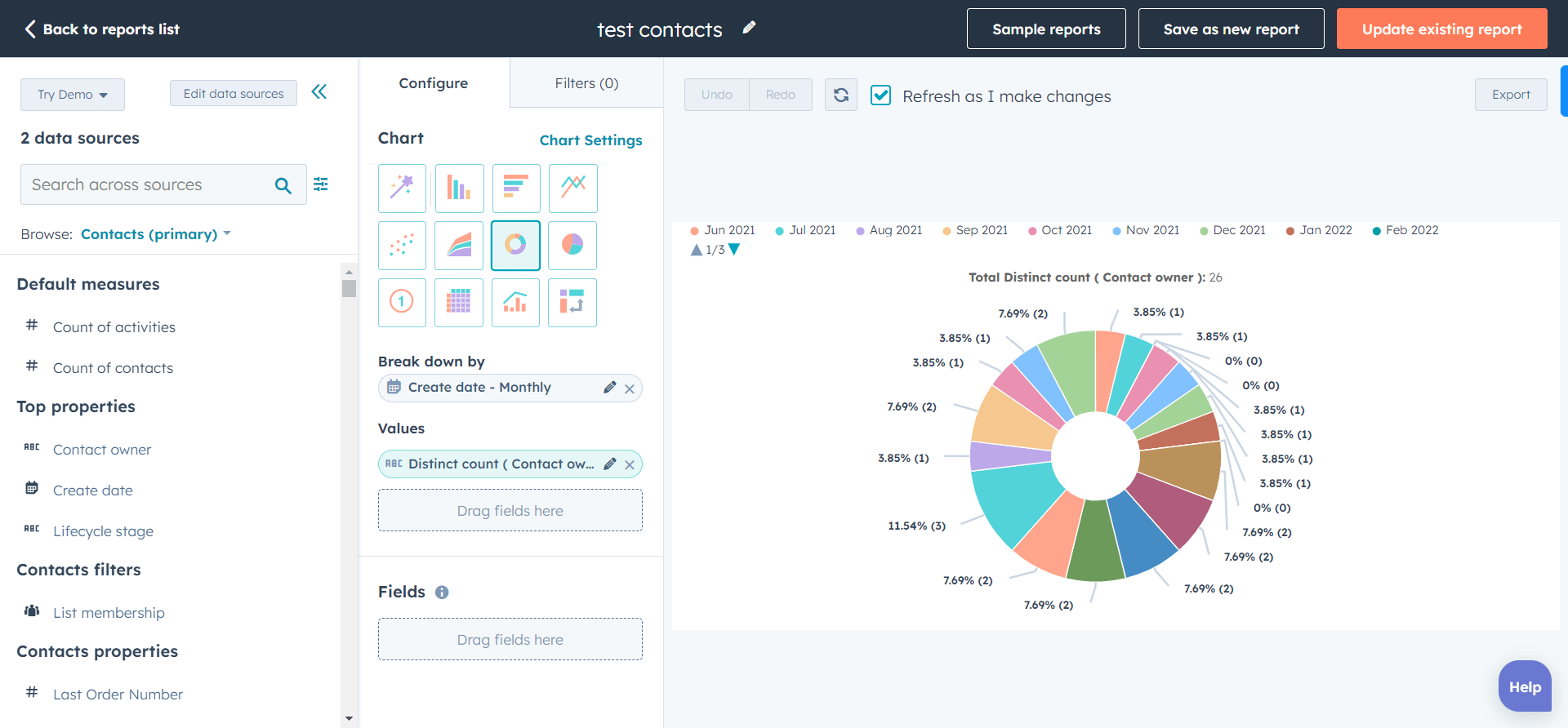
-
Stress-free Data Management from One Place
eCommerce business is a mess. But your data shouldn’t be.
While running your online store, you use dozens of different apps to streamline different process for sales, marketing, operations, etc,
And using a new tool for every problem is as complex as our universe.
Thus, it’s better to keep things simple and manage everything from a central space.
Connecting BigCommerce with HubSpot gets you the same experience. It collects and stores all your store data and lets you track, manage, update, delete, etc. from one point.
It also offers marketing, sales, support friendly features so your team members don’t need to hop onto windows to do different stuff.
Ending words
That was all on how you can connect BigCommerce to HubSpot using our integration.
If you’re also one of the BigCommerce users and looking to
- recover your (almost) lost revenue
- delight your customers with a UX
- close more deals like a sales guru
- automate redundant tasks and grow productivity
- improve collaboration in your team
- make correct and data-driven decisions
- manage all your data from one location to another
So connect BigCommerce to HubSpot using our Integration. It would be the perfect solution for you.
Kill the suffering. Enjoy running your BigCommerce store!
Connect BigCommerce with HubSpot, automate your boring tasks and manage only the stuff that matters.

